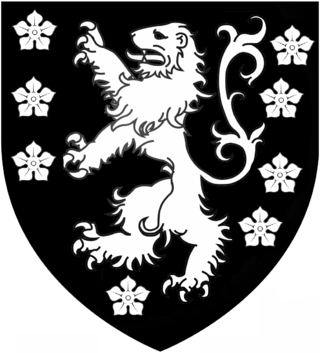Related Research Articles

Viscount Cobham is a title in the Peerage of Great Britain that was created in 1718. Owing to its special remainder, the title has passed through several families. Since 1889, it has been held by members of the Lyttelton family.

Marquess of Ely, of the County of Wexford, is a title in the Peerage of Ireland. It was created in 1800 for Charles Loftus, 1st Earl of Ely. He was born Charles Tottenham, the son of Sir John Tottenham, 1st Baronet, who had been created a baronet, of Tottenham Green in the County of Wexford, in the Baronetage of Ireland in 1780, by Elizabeth, daughter of Nicholas Loftus, 1st Viscount Loftus, sister and heiress of Henry Loftus, 1st Earl of Ely. In 1783 he succeeded to the Loftus estates on the death of his maternal uncle the Earl of Ely and assumed the same year by Royal licence the surname of Loftus in lieu of his patronymic. In 1785 he was raised to the Peerage of Ireland as Baron Loftus, of Loftus Hall in the County of Wexford. It was sold by the family in 1917 and is today owned by the Quigley family.

Sir George Nugent, 1st Baronet, GCB was a British Army officer. After serving as a junior officer in the American Revolutionary War, he fought with the Coldstream Guards under the Duke of York during the Flanders Campaign. He then commanded the Buckinghamshire Volunteers in the actions of St. Andria and Thuyl on the river Waal and participated in the disastrous retreat from the Rhine. He went on to be commander of the northern district of Ireland, in which post he played an important part in placating the people of Belfast during the Irish Rebellion, and then became Adjutant-General in Ireland. He went on to be Governor of Jamaica, commander of the Western District in England, commander of the Kent District in England and finally Commander-in-Chief, India.

Baron Clifton, of Leighton Bromswold in the County of Huntingdon, is a title in the Peerage of England. It was created in 1608 for Sir Gervase Clifton, who commissioned Prebendal house which was built by John Thorpe and later owned by the Clifton baronets branch of the family. The peerage was created by writ, which means that it can descend through both male and female lines. Lord Clifton died without surviving male issue and was succeeded by his daughter Katherine, the second Baroness. She married Esmé Stewart, 3rd Duke of Lennox. They were both succeeded by their eldest son James, the fourth Duke and third Baron. When he died the titles passed to his son, the fifth Duke and fourth Baron. On his death in 1660 at the age of 11, the barony separated from the dukedom. The barony was inherited by the late Duke's sister Mary, the fifth Baroness. She married Richard Butler, 1st Earl of Arran, but died aged only 18. She was succeeded by her first cousin the sixth Duke of Lennox, who became the sixth Baron Clifton as well. He was the son of Lord George Stuart, the fourth son of the third Duke and the second Baroness Clifton. On his death, the barony and dukedom again separated.
Sir Arthur Gore, 1st Baronet was an Irish soldier and politician.
Sir Roger Jones, 1st Viscount RanelaghPC (Ire) was joint Lord President of Connaught with Charles Wilmot, 1st Viscount Wilmot. He commanded the government forces in Connaught during the Irish Rebellion of 1641 and the beginning of the Irish Confederate Wars defending Athlone against James Dillon until February 1643.
Sir Ralph Gore, 4th Baronet was a Speaker of the Irish House of Commons. He is now chiefly remembered for building Belle Isle Castle.
There have been two baronetcies created for persons with the surname St George, both in the Baronetage of Ireland. One creation is extant as of 2010.
Sir Richard Bulkeley, 1st Baronet was an Irish politician and baronet.
Theophilus Blakeney was an Irish politician.
Charles Stanley Monck, 1st Viscount Monck, was born in 1754 and died on 9 June 1802. He was the 1st son of Thomas Monck MP, by his wife, Judith Mason, daughter of Robert Mason, of Mason Brook.
Sir William Parsons, 1st Baronet of Bellamont, PC (Ire), was known as a "land-hunter" expropriating land from owners whose titles were deemed defective. He also served as Surveyor General of Ireland and was an undertaker in several plantations. He governed Ireland as joint Lord Justice of Ireland from February 1640 to April 1643 during the Irish rebellion of 1641 and the beginning of the Irish Confederate War.
Thomas Bligh was an Irish politician.
Sir George St George, knight, of Dunmore was an Irish Member of Parliament. He represented Carrick in the Irish House of Commons from September 1703 to his death, sitting alongside his nephew Oliver St George.
Sir Richard St George was an Irish landowner.
Sir Thomas Southwell, 1st Baronet, of Castle Mattress was a high sheriff of County Kerry under the Protectorate.
Sir Robert Talbot, 2nd Baronet of Carton was an Irish landowner, soldier, and politician. He sat for County Wicklow in the Irish parliament 1634–1635.
George St George was an Irish politician. He sat in the Irish House of Commons as a Member of Parliament (MP) for Athlone from 1723 to 1761.
Sir Richard Bligh St George, 2nd Baronet was an Anglo-Irish politician.
Thomas Cherburgh Bligh was an Anglo-Irish Whig politician who served in the Irish House of Commons and the Parliament of Great Britain.
References
- ↑ E. M. Johnston-Liik, MPs in Dublin: Companion to History of the Irish Parliament, 1692-1800 (Ulster Historical Foundation, 2006). (Retrieved 21 April 2020).